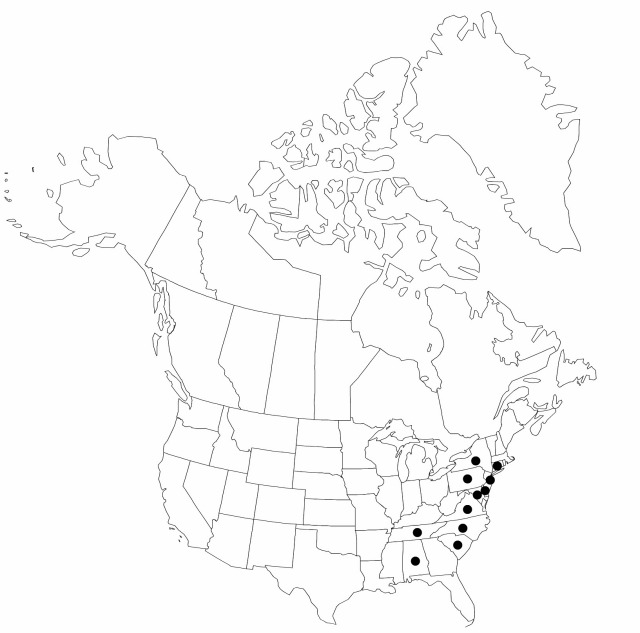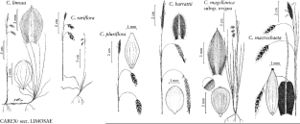Difference between revisions of "Carex barrattii"
Ann. Lyceum Nat. Hist. New York 1: 361. 1825.
FNA>Volume Importer |
imported>Volume Importer |
||
| (6 intermediate revisions by 2 users not shown) | |||
| Line 6: | Line 6: | ||
|place=1: 361. 1825 | |place=1: 361. 1825 | ||
|year=1825 | |year=1825 | ||
| + | }} | ||
| + | |special_status={{Treatment/ID/Special_status | ||
| + | |code=F | ||
| + | |label=Illustrated | ||
| + | }}{{Treatment/ID/Special_status | ||
| + | |code=E | ||
| + | |label=Endemic | ||
}} | }} | ||
|basionyms= | |basionyms= | ||
| Line 23: | Line 30: | ||
|elevation=0–500 m | |elevation=0–500 m | ||
|distribution=Ala.;Conn.;Del.;Md.;N.J.;N.Y.;N.C.;Pa.;S.C.;Tenn.;Va. | |distribution=Ala.;Conn.;Del.;Md.;N.J.;N.Y.;N.C.;Pa.;S.C.;Tenn.;Va. | ||
| − | |discussion=<p>Carex barrattii is in the Center for Plant Conservation’s National Collection of Endangered Plants.</p> | + | |discussion=<p><i>Carex barrattii</i> is in the Center for Plant Conservation’s National Collection of Endangered Plants.</p> |
|tables= | |tables= | ||
|references= | |references= | ||
| Line 32: | Line 39: | ||
-->{{#Taxon: | -->{{#Taxon: | ||
name=Carex barrattii | name=Carex barrattii | ||
| − | |||
|authority=Schweinitz & Torrey | |authority=Schweinitz & Torrey | ||
|rank=species | |rank=species | ||
| Line 46: | Line 52: | ||
|publication title=Ann. Lyceum Nat. Hist. New York | |publication title=Ann. Lyceum Nat. Hist. New York | ||
|publication year=1825 | |publication year=1825 | ||
| − | |special status= | + | |special status=Illustrated;Endemic |
| − | |source xml=https:// | + | |source xml=https://bitbucket.org/aafc-mbb/fna-data-curation/src/2e0870ddd59836b60bcf96646a41e87ea5a5943a/coarse_grained_fna_xml/V23/V23_762.xml |
|genus=Carex | |genus=Carex | ||
|section=Carex sect. Limosae | |section=Carex sect. Limosae | ||
Latest revision as of 21:42, 5 November 2020
Culms aphyllopodic, without dead leaf remains at base, 20–90 cm. Leaf blades 2–5 mm wide, margins revolute, scabrid at tip. Inflorescences: proximal bracts 2–7 cm, shorter than inflorescences; lateral spikes usually androgynous, (10–)25–50 × 3.5–6 mm, with 20–80 perigynia; terminal spikes 20–50 × 2.5–5 mm. Pistillate scales ovate, 2.4–4 × 1.3–1.8 mm, shorter and as wide as or slightly narrower than perigynia, apex obtuse to acute. Staminate scales oblong-obovate, 3.7–4.5 × 1.2–2 mm, apex obtuse. Anthers 2.6–2.9 mm. Perigynia 2.5–3.5 × 1.2–2 mm, apex rounded; beak 0.1–0.5 mm.
Phenology: Fruiting late spring–early summer.
Habitat: Bogs, swamps, wet woods, primarily on acidic substrata
Elevation: 0–500 m
Distribution

Ala., Conn., Del., Md., N.J., N.Y., N.C., Pa., S.C., Tenn., Va.
Discussion
Carex barrattii is in the Center for Plant Conservation’s National Collection of Endangered Plants.
Selected References
None.
